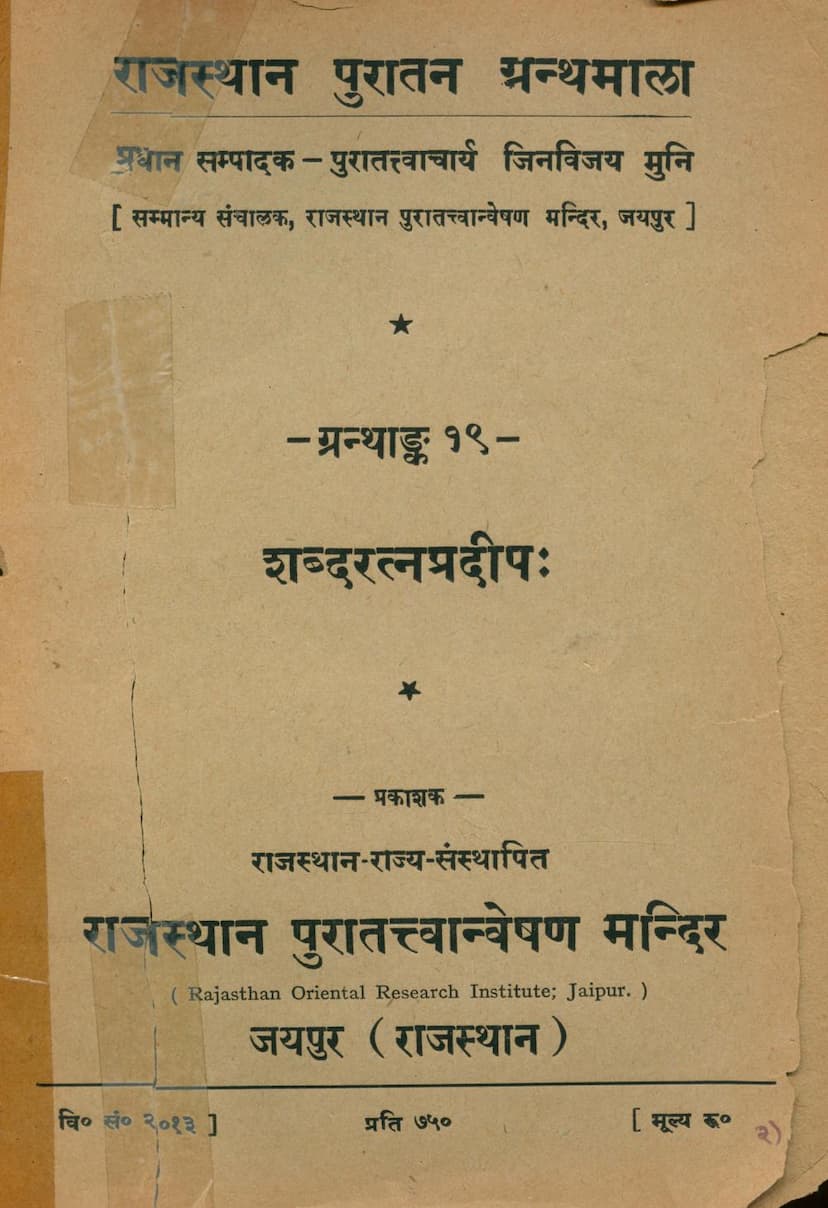Shabdaratna Pradip
Added to library: September 2, 2025

Summary
Here's a comprehensive summary of the Jain text "Shabdaratnapradipa" by Hariprasad Shastri, based on the provided pages:
Book Title: Shabdaratnapradipa Author: Hariprasad Shastri Publisher: Rajasthan Purattvanveshan Mandir Series: Rajasthana Puratana Granthamala (No. 19) Year of Publication: 1956 (V.S. 2013)
Overview:
"Shabdaratnapradipa" is a Sanskrit lexicon (dictionary) of considerable significance, published as the 19th volume in the "Rajasthana Puratana Granthamala" series by the Rajasthan Oriental Research Institute. The work was discovered in the Jain Jñāna Bhandāras (libraries) of Jaisalmer. While the author's name is not explicitly mentioned in the manuscripts, the editor, Professor Dr. Hariprasad Shastri, along with the General Editor Muni Jinavijaya, presents compelling evidence suggesting the author was likely a Jain scholar.
Content and Structure:
The lexicon is primarily a work that elucidates the multiple meanings of Sanskrit words, particularly homonyms. It is divided into five "Muktaka" (cantos or sections):
-
First Three Muktakas (ślokādhagāminaḥ, ślokārdhagāminaḥ, ślokapādādhagāminaḥ): These sections focus on homonyms (words with the same spelling but different meanings). They are categorized based on the length of the verse required to explain the various meanings of each word:
- Ślokādhikāra (Full Verse): Words requiring a full verse to list their meanings.
- Ardhādhikāra (Half Verse): Words whose meanings can be explained within half a verse.
- Pādādhikāra (Quarter Verse): Words whose meanings are covered in a quarter verse. This system of classifying homonyms by verse length was common in ancient Sanskrit lexicons. The text does not arrange words alphabetically but rather in a seemingly random order, making an index essential.
-
Fourth Muktaka (Technical Terms): This section is dedicated to explaining the meanings of technical terms from various fields, including politics, administration, military concepts, cattle, body parts, colors, time, sacrifice, and more.
-
Fifth Muktaka (Indeclinables): This section deals with Sanskrit indeclinables (avyaya), many of which also carry multiple meanings. These are presented in various verse lengths, not strictly adhering to the system used for homonyms.
Key Features and Scholarly Observations:
-
Jain Authorship Hypothesis:
- The General Editor, Muni Jinavijaya, points to specific word meanings that are characteristic of Jain terminology. For instance, the meaning of "Jina" as "Sāmānyakevalin" (a Kevalin who is not a Tirthankara) is considered a distinctly Jain usage.
- The meaning of "Jayanti" as "Anujā of Cetaka" is also linked to Jain narrative literature, though there's a slight discrepancy with traditional Jain accounts of Jayanti's relationship to Cetaka. These specific references lead to the strong possibility that the author was a Jain.
-
Manuscripts and Editorial Process:
- The edition is primarily based on two undated paper manuscripts from Jaisalmer. A third manuscript (C) from a different Bhandar was used for collation, providing some corresponding chapters.
- Professor K. K. Shastri meticulously copied manuscript A and collated it with B and C, noting variants. Dr. Hariprasad Shastri prepared the edition based on this material, selecting apt readings and attempting to correct obvious clerical errors.
- Some readings remained doubtful due to the unavailability of the original manuscripts during the finalization of the edition, especially in the fifth Muktaka, which was copied less satisfactorily.
-
Lexical Work and Its Significance:
- The title "Shabdaratnapradipa" itself signifies a "lamp of word-jewels," aptly describing the work's purpose of illuminating the meanings of words.
- The work contributes to the rich tradition of Sanskrit lexicography, following in the footsteps of renowned lexicons like Amara, Vishva, and others.
- It's noted that while it covers homonyms and technical terms, it does not include synonyms extensively, making it distinct from a comprehensive thesaurus.
-
Dating:
- The work is tentatively dated to between the 7th and 12th centuries CE, with a lower limit of the 13th century as it's quoted in a work from V.S. 1295 (1238-39 A.D.). The lack of systematic arrangement of homonyms suggests an earlier date, possibly before the influence of works like the Śāśvata Kośa that adopted systematic orders.
-
Metaphorical Language:
- The cantos are referred to as "Muktaka" by one manuscript and "Lokādhikāra," "Ardhalokādhikāra," and "Pādādhikāra" in others, reflecting the classification by verse length. The term "Muktaka" is interpreted as "pearls" in the context of the work's metaphor.
-
Praise and Purpose:
- The introductory verses invoke Sarasvati, the goddess of speech.
- The work aims to make the vast Sanskrit vocabulary accessible to scholars and those devoted to Sanskrit literature.
In summary, "Shabdaratnapradipa" is a valuable Sanskrit lexicon compiled by an unidentified author, likely a Jain scholar, and critically edited by Hariprasad Shastri. It systematically explains the multiple meanings of Sanskrit words, categorizes technical terms, and lists indeclinables, making it an important resource for understanding Sanskrit vocabulary and its nuances, particularly within the context of Jain intellectual traditions.